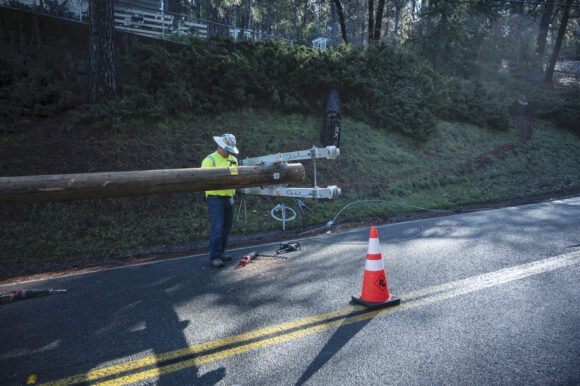SACRAMENTO, Calif. (AP) _ Thousands of residents in the Sierra Nevada remained without running water, heat or power nearly two weeks after a powerful December storm dumped heavy snow that downed trees and damaged electrical equipment.
More than 250 crews were working Saturday to restore power to nearly 7,000 Pacific Gas & Electric customers in its Sierra Division, including El Dorado, Placer, Nevada and Sierra counties, said Karly Hernandez, a spokesperson for the utility.
After a Dec. 26 storm knocked out their power, Elisabeth Jones and her wife have been relying on their wood-burning stove to warm up the house and store-bought ice to keep food fresh in their coolers. Because their home uses a well and powered pump for water, they don’t have running water and have resorted to urinating in a bucket filled with straw, Jones told the Sacramento Bee.
The pair skipped showering for days and wore the same unwashed clothes, because they want to avoid laundromats amid the surging spread of COVID-19.
“It is truly a nightmare, but it’s so much worse for people with small children or an elderly person who need to charge up their oxygen tank,” Jones said. “It doesn’t have to be this way; that’s what’s so enraging.”
The storm was part of a record month of snow for the region, with parts of the Sierras recording nearly 18 feet (5.5 meters) of snow, more than any other December in the past 142 years, the University of California-Berkeley’s Central Sierra Snow Lab reported.
The snow weakened trees, causing branches to snap onto power lines.
“We could just hear stuff crashing all around us,” Kim Ummel told the newspaper. “Trees were falling all around us.”
She said her home in Alta Sierra wasn’t seriously damaged, but going without electricity for days has left her anxious.
Electricity has been restored to the vast majority of households who lost their power during the storm, but the prolonged outage has especially been hard for people with disabilities or health issues, who use electrical medical devices like motorized wheelchairs, ventilators, respirators and apnea monitors.
Melissa Kasnitz, legal director for the Center for Accessible Technology, said people with disabilities or with medical needs can experience “subtle harms” during an outage. They include people with diabetes who rely on insulin, which needs to be refrigerated. Others are sensitive to dramatic temperature changes, or are at-risk to the adverse effects of COVID-19 and can’t go to resource centers.
“Some people will say, `Oh it’s just an inconvenience and people need to deal with it,”’ Kasnitz said. “Those are the people with good health or emergency kits or can find a place to go.”
PG&E and local counties have opened resource centers where residents can take showers, wash clothes, recharge their batteries and devices and restock firewood and propane. PG&E said it expects to fully restore power by Tuesday.
About the photo: Contractors work on a power pole on Thursday, Jan. 6, 2022, on Norlene Way in Alta Sierra as more than 7,800 PG&E customers in Nevada County where still without power more than a week after heavy snow storms in the Sierra. Thousands of residents in the Sierra Nevada remained without running water, heat or power nearly two weeks after a powerful December snowstorm downed trees and damaged electrical equipment. (Hector Amezcua/The Sacramento Bee via AP
Was this article valuable?
Here are more articles you may enjoy.


 Lawsuits Against BP Over Health Impacts of Deepwater Horizon Cleanup Stalled in Court
Lawsuits Against BP Over Health Impacts of Deepwater Horizon Cleanup Stalled in Court  AI Weather Models Promise Super Granular, Specialist Forecasts
AI Weather Models Promise Super Granular, Specialist Forecasts  FBI Says Cybercrime Costs Rose to at Least $16 Billion in 2024
FBI Says Cybercrime Costs Rose to at Least $16 Billion in 2024  La Niña’s End Threatens to Unleash an Active Atlantic Hurricane Season
La Niña’s End Threatens to Unleash an Active Atlantic Hurricane Season 